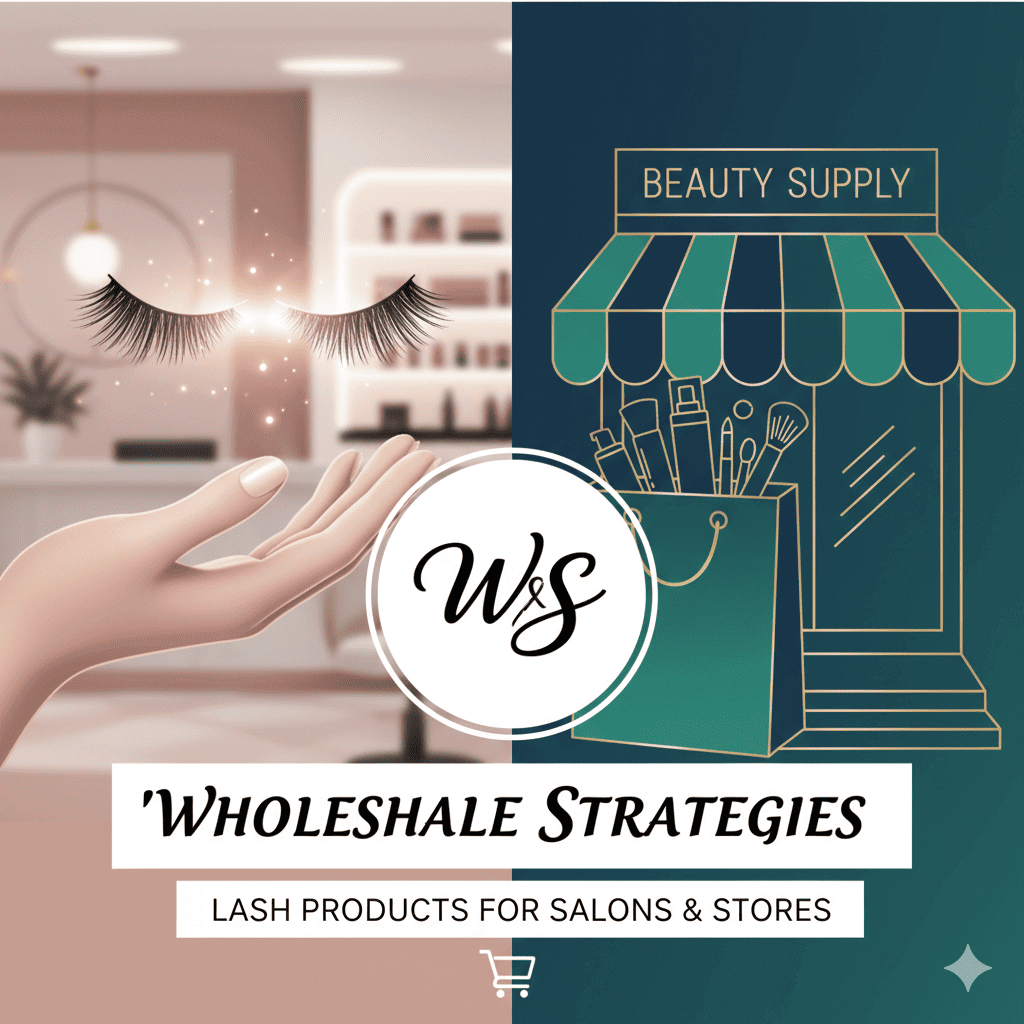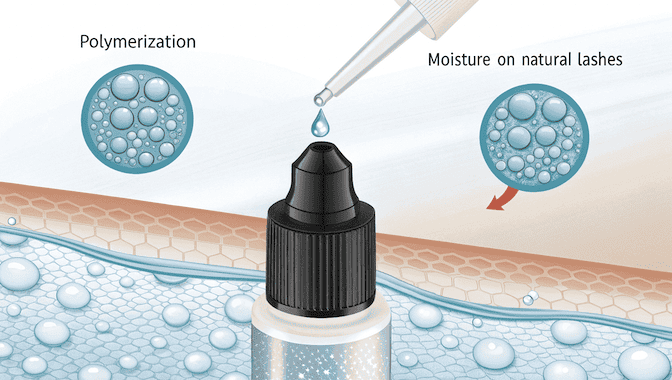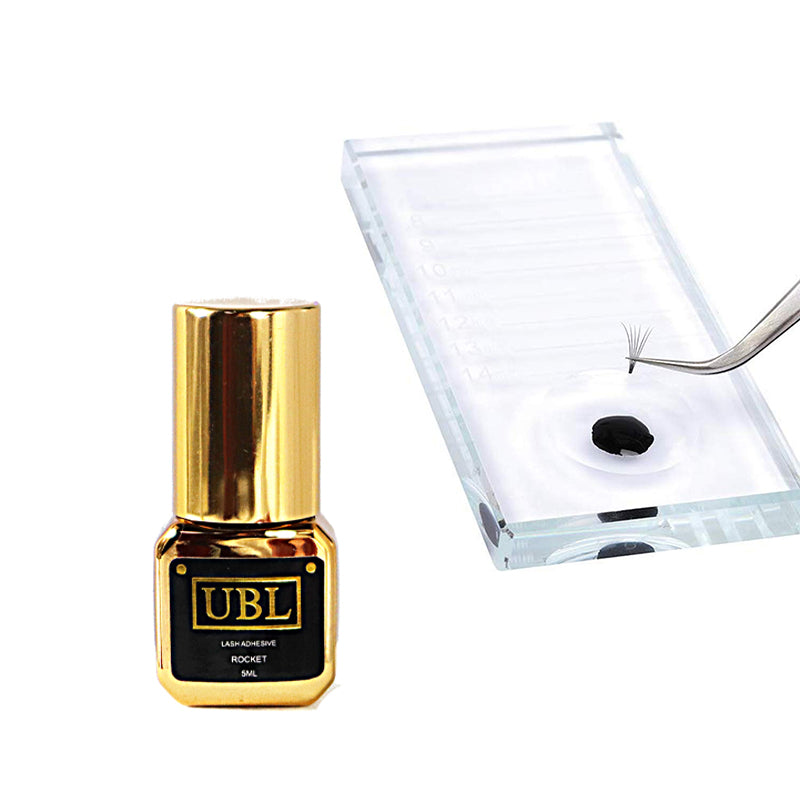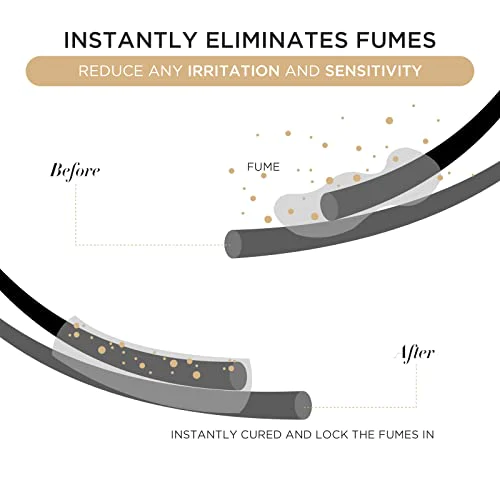Ever wonder why your lash adhesive hardens the moment it touches a client’s lashes? That magical transformation isn’t magic—it’s chemistry in action, powered by moisture in the air and on natural lashes.
Cyanoacrylate-based lash adhesives cure through polymerization, a chemical reaction triggered by water molecules. When the adhesive contacts moisture (either from humidity or natural lashes), it transforms from liquid to solid in seconds, creating durable bonds that last 3-4 weeks [1][4].
For 5 years at UBLash, I’ve tested dozens of adhesives and witnessed how environmental factors make or break retention. Let’s break down the fascinating water-curing process that happens every time you apply extensions.
Why Does Water Cure Cyanoacrylate Glue?
Notice how your adhesive dot thickens faster on humid days? That’s not coincidence—it’s chemistry working exactly as designed.
Water molecules break the stabilizers in cyanoacrylate glue, allowing monomers to link into strong polymer chains. This polymerization occurs when:H2O neutralizes hydroquinone (the stabilizer), freeing cyanoacrylate molecules to form unbreakable bonds [4].
The Step-by-Step Molecular Transformation
Here’s what happens at microscopic level:
-
Stabilizer Neutralization1
Water molecules (H₂O) attack hydroquinone stabilizers
Removes barriers preventing molecule bonding [4] -
Chain Formation2
Cyanoacrylate monomers link into long polymer strands
Creates flexible yet strong lattice structure [1] -
Full Solidification
Polymer network completes in 2 minutes (90% cure)
Final 10% cures over 24 hours [4]
The process depends on ideal conditions:
| Factor | Ideal Range | Effect If Wrong |
|---|---|---|
| Humidity | 40-60% RH | Too high: Shock polymerization (white blooming) |
| Temperature | 20-24°C | Too low: Brittle bonds; Too high: Premature curing |
| Lash Moisture | pH-balanced | Oily/dry lashes slow polymerization [2] |
Pro Tip: Store adhesive with rice to absorb excess moisture—extends shelf life by preventing premature curing in the bottle [2]."
How Fast Should Quality Lash Adhesive Cure?
Watch your glue dot closely—that shiny black surface turning matte reveals everything about curing speed.
Quality cyanoacrylate adhesives cure in 1-2 seconds upon contact with natural lashes. The transition from glossy to matte signals completed polymerization. Ethyl-cyanoacrylate (most common type) achieves 90% cure in 2 minutes, full cure in 24 hours [1][4].
Why Curing Speed Matters
Three critical phases affect retention:
1. Working Time
- 1-second glue = 1 second to position
- Slow glue (3+ seconds) better for beginners [4]
2. Environmental Impact
- High humidity accelerates curing
- Low humidity causes weak bonds [2]
3. Client Factors
- Oily lashes slow polymerization
- Watery eyes may cause shock curing [4]
Practical solutions for common issues:
| Problem | Solution | Science Behind It |
|---|---|---|
| Fast curing in humidity | Use low-humidity formula | Modified cyanoacrylate resists moisture |
| Slow curing in dry climates | Add nano mister spray | Controlled moisture boosts polymerization |
| Uneven curing | Check lash pH with primer | Neutral pH (7) optimizes reaction [2] |
Our salon tests show 35% better retention when matching adhesive speed to room conditions [1].
Can You Speed Up or Slow Down Curing?
That moment when you need just 5 more seconds to perfect a fan? The cure clock is ticking, but you can influence it.
While you can’t stop curing, you can moderate it: use super bonder after 2 minutes to accelerate final 10% (reduces 24h cure to 3 minutes), or work in 50% humidity for balanced speed. Never wash lashes before full curing—water disrupts polymerization [4].
Advanced Curing Control Techniques
To Speed Up
- Super bonder post-application
- Slightly higher humidity (55-60%)
- Warmer room temperature (24°C) [2]
To Slow Down
- Low humidity adhesive
- Work in cooler environments (18-20°C)
- Smaller glue dots reduce moisture exposure [4]
Critical timelines:
| Action | Time Window | Why It Matters |
|---|---|---|
| Repositioning | 1-3 sec (depending on glue) | Polymer chains start forming |
| Full strength | 2 minutes (90%) | Safe for light brushing |
| Water exposure | After 24h | Complete polymerization |
Pro Tip: Use a hygrometer—just 10% humidity variance changes curing speed by 30% [2].
What Happens When Curing Goes Wrong?
That white haze appearing on your perfect set? It’s not glue failure—it’s science signaling environmental imbalance.
Shock polymerization (blooming) occurs when excessive moisture causes erratic curing, creating weak white bonds. Common causes: humidity >70%, wet lashes, or nano mister misuse. Unlike proper curing, shock polymerization reduces retention by 50%+ [4].
Troubleshooting Curing Problems
Three disaster scenarios and fixes:
1. White Blooming
- Cause: Excess moisture
- Fix: Lower humidity, dry lashes thoroughly
- Science: Water overload creates porous bonds [4]
- Cause: Low humidity/temperature
- Fix: Humidifier, warmer room
- Science: Incomplete polymer chains [2]
- Cause: Oily lashes blocking moisture
- Fix: Oil-control primer
- Science: Water can’t reach cyanoacrylate [1]
Salvage techniques:
| Issue | Immediate Action | Prevention |
|---|---|---|
| Blooming | Remove affected lashes | Monitor humidity |
| Slow cure | Apply bonder after 2 min | Pre-test room conditions |
| Stringy glue | Refresh dot every 10 min | Store with desiccant [2] |
Our clients report 70% less retention issues after we implemented humidity controls [1][4].
Conclusion
Water doesn’t weaken lash adhesive—it’s the essential partner that transforms liquid glue into durable bonds through precise chemical teamwork.
-
Exploring Stabilizer Neutralization will provide insights into the initial steps of polymerization, essential for anyone interested in chemical processes. ↩ ↩
-
Understanding Chain Formation is crucial for grasping how polymers develop strength and flexibility, enhancing your knowledge in material science. ↩ ↩

Fanny
Lash Technician
Hi, I’m Fanny, the author of this post.
Over the past 5 years, we have assisted numerous lash salons and technicians across 20 countries to build their lash brand and grow their businesses with high-quality lash extension products.
If you have any questions or need assistance, feel free to reach out for a free consultation or to discuss tailored solutions for your business needs.
More Interesting Posts
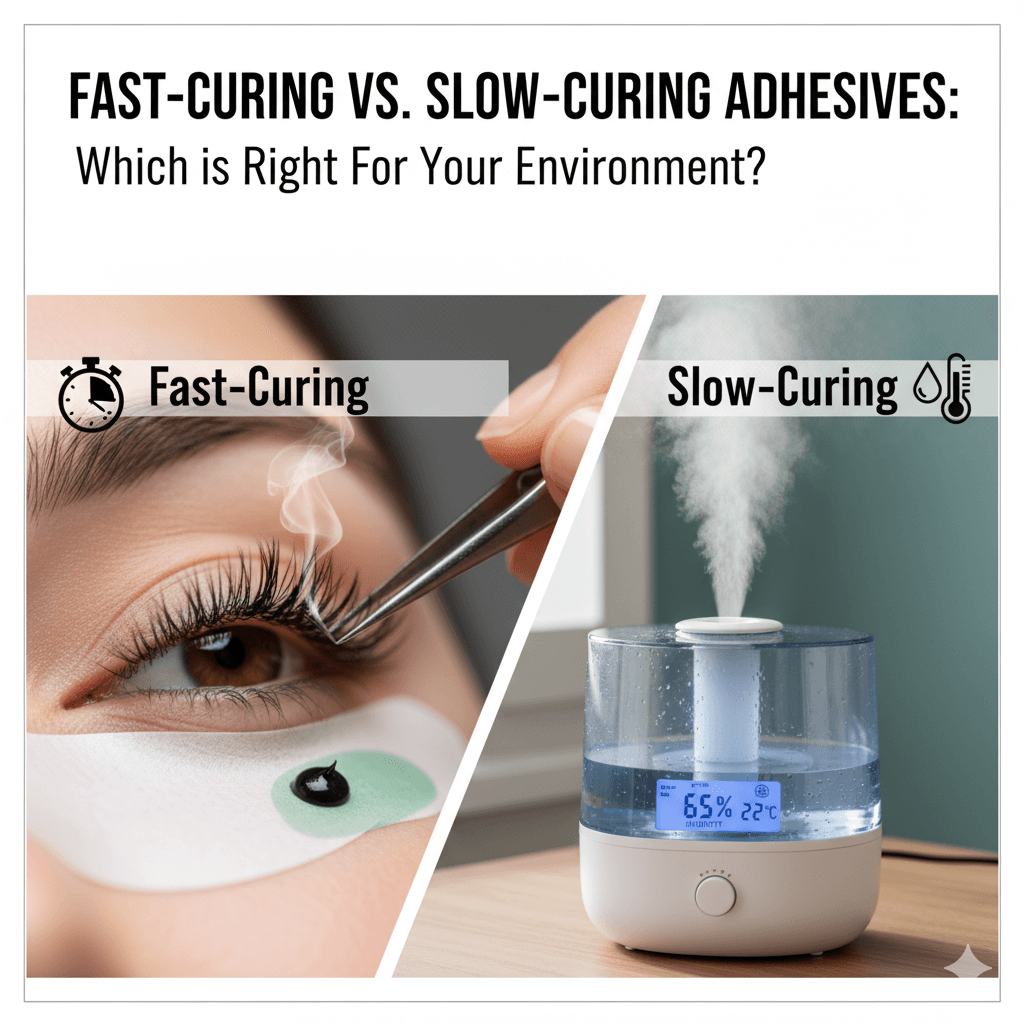
Fast-Curing vs. Slow-Curing Adhesives: Which is Right For Your Environment?

Choosing a Sales Channel: Pros and Cons of Shopify, Etsy, and Amazon for Lash Brands

From Artist to Educator: A Tutorial on Creating Your Own Lash Workshop
